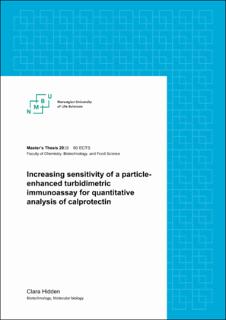| dc.contributor.advisor | Vaaje-Kolstad, Gustav | |
| dc.contributor.advisor | Sundrehagen, Erling | |
| dc.contributor.advisor | Nilsen, Tom | |
| dc.contributor.author | Hidden, Clara Mathilde | |
| dc.date.accessioned | 2021-02-25T13:14:57Z | |
| dc.date.available | 2021-02-25T13:14:57Z | |
| dc.date.issued | 2019 | |
| dc.identifier.uri | https://hdl.handle.net/11250/2730446 | |
| dc.description.abstract | Calprotectin is a protein that is released by activated leukocytes and monocytes. Increased levels of the protein are found in patients with inflammatory and autoimmune conditions, including juvenile idiopathic arthritis (JIA), a childhood group of diseases causing inflammation of the joints.
In this thesis, the Gentian Calprotectin Immunoassay (GCAL®) was adjusted to allow accurate measurements of calprotectin concentrations under 0.5 mg/L in human blood samples. The adjusted highly sensitive assay (hsGCAL) was tested on serum samples from children with various forms of JIA for a selection of laboratory and clinical parameters. The effects on sensitivity of using different parts of the avian antibody immunoglobulin Y (IgY) in the assay was also assessed.
The results show that the hsGCAL assay (with adjusted calibrator set and 8 uL sample volume) meets the criteria for linearity in the range 0.05 – 10.4 mg/L (on Abbott Architect c4000) with a security zone up to at least 60 mg/L (highest concentration tested). The results also show improved/lower CV (%) compared to the reference assay (GCAL®). The results indicate that the adjustments performed and tested in this thesis have the potential to increase the sensitivity of the GCAL® assay.
Also, a stronger turbidimetric signal was observed when only using the immunoparticles coated with the monomeric fraction of anti-calprotectin IgY only, compared to fractions containing combinations of different fractions of IgY. This indicates that the GCAL® assay may benefit from using monomeric antibodies instead of total IgY.
An increased sensitivity in the lower calprotectin concentration range could be beneficial when used to diagnose diseases where there is little difference in the calprotectin concentration between a healthy and a diseased person. However, no statistical differences between GCAL® and hsGCAL were found in serum samples of JIA patients, indicating that for this patient group there is no need for the added sensitivity provided by the hsGCAL assay. | en_US |
| dc.language.iso | eng | en_US |
| dc.publisher | Norwegian University of Life Sciences, Ås | en_US |
| dc.rights | Attribution-NonCommercial-NoDerivatives 4.0 Internasjonal | * |
| dc.rights.uri | http://creativecommons.org/licenses/by-nc-nd/4.0/deed.no | * |
| dc.subject | calprotectin | en_US |
| dc.subject | immunoassay | en_US |
| dc.subject | turbidimetry | en_US |
| dc.title | Increasing sensitivity of a particle-enhanced turbidimetric immunoassay for quantitative analysis of calprotectin | en_US |
| dc.type | Master thesis | en_US |
| dc.subject.nsi | VDP::Technology: 500::Nanotechnology: 630 | en_US |
| dc.subject.nsi | VDP::Mathematics and natural science: 400::Chemistry: 440::Organic chemistry: 441 | en_US |
| dc.description.localcode | M-BIOTEK | en_US |

